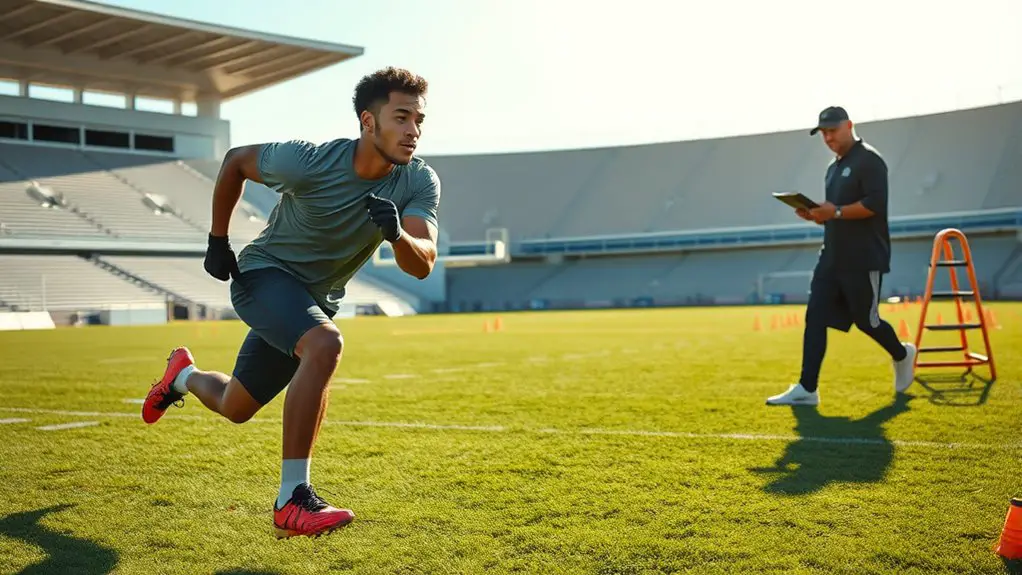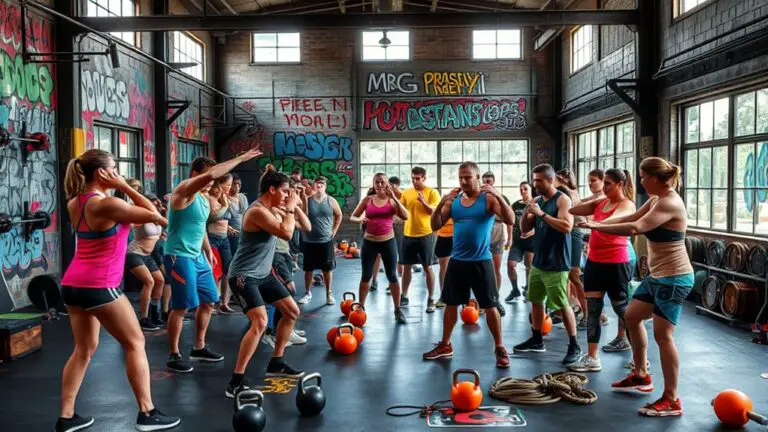How to Train Like a Professional Football Player

To train like a professional football player, you need to adopt a disciplined mindset and set clear goals. Prioritize strength and conditioning with weights, cardio, and flexibility training. Focus on developing technical skills through targeted drills, while enhancing agility and speed with quick footwork exercises. Don’t forget recovery strategies, like proper nutrition and rest, to keep your body functioning at its best. These fundamentals will elevate your game and prepare you to access your full potential. Discover more strategies to sharpen your training.
Understanding the Professional Mindset

Understanding the professional mindset is vital for anyone aspiring to reach the heights of football excellence. It’s not just about talent; it’s about cultivating a professional discipline that sets you apart from the rest. You’ve got to approach every training session with the intent to improve, pushing your limits consistently. This means being punctual, staying focused, and showing up ready to give your all.
Moreover, embracing a competitive mindset is fundamental. You should view every drill and practice as an opportunity to outshine your competitors. This mentality drives you to work harder, stay motivated, and adapt to challenges. Reflect on your progress regularly and set clear goals—both short-term and long-term. This method allows you to maintain a trajectory towards excellence while fostering resilience. Remember, every successful player started with a mindset that prioritized discipline and competition, so adopt these principles to access your full potential.
Building Strength and Conditioning
To build strength and conditioning like a professional player, you need a balanced approach that encompasses weight training fundamentals, cardiovascular endurance techniques, and flexibility exercises. Each component plays an essential role in enhancing your overall performance and reducing injury risk. By integrating these elements into your routine, you’ll not only improve your physical capabilities but also boost your confidence on the field. Incorporating stretching at home before workouts can help warm up your muscles and improve flexibility, setting a solid foundation for your training.
Weight Training Fundamentals
Building strength and conditioning is essential for any aspiring football player looking to elevate their game. To achieve this, you need to focus on effective weightlifting techniques and incorporate resistance training into your routine. Start with foundational exercises like squats, deadlifts, and bench presses, which target major muscle groups. Aim for compound movements that enhance overall strength and functional performance. It’s vital to maintain proper form to prevent injuries and maximize gains. Gradually increase the weight as you progress, ensuring you challenge yourself without compromising technique. Remember, consistency is key. Integrate weight training at least three times a week, balancing it with recovery days. This approach will help you build the explosive strength needed for the demands of professional football.
Cardiovascular Endurance Techniques
How can you enhance your on-field performance while also boosting your overall stamina? Focusing on cardiovascular endurance is key. Incorporate high intensity intervals into your training to increase your heart rate and build explosive power. Meanwhile, steady state running helps develop your aerobic capacity for longer games.
Here’s a practical breakdown:
| Technique | Duration | Benefits |
|---|---|---|
| High Intensity Intervals | 20-30 min | Builds speed and power |
| Steady State Running | 30-60 min | Improves endurance and stamina |
| Fartlek Training | 30-45 min | Combines speed with endurance |
| Tempo Runs | 20-40 min | Enhances lactate threshold |
Flexibility and Mobility Exercises
Flexibility and mobility are essential components of a football player’s training regimen, often overlooked but crucial for enhancing performance and preventing injuries. Incorporating dynamic stretches into your warm-up routine can greatly improve your joint mobility, allowing for better agility and speed on the field. Focus on exercises like leg swings and walking lunges to increase blood flow and prepare your muscles for action. Additionally, dedicate time post-workout to static stretching and foam rolling, targeting tight areas. Regularly practicing these flexibility and mobility exercises not only enhances your range of motion but also helps in recovery. Remember, a well-rounded training program prioritizes both strength and flexibility, leading to a more resilient athlete ready to tackle any challenge on the field.
Developing Technical Skills
To elevate your game, mastering ball control techniques is essential for maintaining possession under pressure. Improving your passing accuracy and enhancing your dribbling skills will make you a more versatile player on the field. Focused practice in these areas not only builds confidence but also sets you apart from the competition.
Master Ball Control Techniques
Mastering ball control is essential for any aspiring football player, as it serves as the foundation for all technical skills on the pitch. To develop this vital ability, you should focus on dedicated ball control drills and footwork exercises. Start with simple drills like juggling the ball or using your thighs and feet to keep it in the air. Gradually increase the difficulty by incorporating cones and obstacles to enhance your agility and precision. Consistency is key—set aside time each day to practice these techniques. Remember, the better your ball control, the more confident you’ll feel during matches. Embrace the challenge, stay committed, and watch your skills transform as you become a more dynamic player on the field.
Improve Passing Accuracy
Once you’ve honed your ball control, the next step is to improve your passing accuracy. This skill is essential for effective gameplay. Start by incorporating targeted passing drills into your routine. Set up cones or markers to simulate game scenarios, and aim for precise passes between them. This will enhance your ability to assess distance and angle.
In addition to drills, engage in target practice. Use a wall or a partner to pass the ball, focusing on hitting specific spots consistently. Track your progress; this feedback will motivate you to push further. Remember, the more you practice, the more instinctive it becomes. With dedication, your passing accuracy will rise, setting you on the path to becoming a more effective player.
Enhance Dribbling Skills
Dribbling is the heartbeat of football, allowing players to maneuver past defenders and create scoring opportunities. To enhance your dribbling skills, you need to engage in focused dribbling drills that challenge your control and agility. Start with basic cone drills to refine your footwork, then progress to more complex skill challenges that mimic game situations. Incorporate one-on-one scenarios to develop your ability to read defenders and make quick decisions. Remember, consistency is key; practice daily and push your limits. Set specific goals for each session, whether it’s increasing speed or mastering new techniques. By committing to these practices, you’ll notice improved confidence on the ball, enabling you to outpace opponents and elevate your overall game.
Enhancing Agility and Speed
To truly elevate your performance on the field, focusing on agility and speed is essential, as these attributes can make the difference between a good player and a great one. Incorporating specific agility drills and speed workouts into your routine will greatly enhance your game.
| Agility Drills | Speed Workouts |
|---|---|
| Ladder Drills | Sprints (Short Dist.) |
| Cone Drills | Fartlek Training |
| Shuttle Runs | Hill Sprints |
Start with ladder drills to improve footwork and coordination. Then, move on to cone drills for quick directional changes. For speed, prioritize short sprints to develop explosive power and incorporate fartlek training for endurance. Consistency is key—aim for at least three sessions per week. Remember, the faster and more agile you become, the better you’ll navigate the field, leaving defenders in your dust. Stay motivated, and push your limits!
Incorporating Recovery and Nutrition

Improving your agility and speed is just one part of the equation for peak performance on the field. To truly excel, you need to focus on recovery and nutrition. Your body requires proper fuel and rest to repair and build muscle, ensuring you’re ready for the next challenge. Here are some key strategies to incorporate:
- Prioritize nutritional timing: Eat balanced meals before and after workouts to optimize performance and recovery.
- Hydrate consistently: Maintain hydration to support muscle function and recovery processes.
- Utilize active recovery: Engage in low-intensity activities like walking or yoga to promote blood flow.
- Incorporate rest days: Allow your muscles adequate time to recover to prevent injury.
- Focus on sleep quality: Aim for 7-9 hours of restful sleep to enhance recovery and overall performance.
Mental Preparation and Focus Techniques
While physical training is essential, mental preparation can set you apart as a football player. To sharpen your focus and enhance performance, consider integrating visualization techniques and mindfulness practices into your routine. These tools help cultivate a winning mindset, enabling you to perform under pressure.
| Technique | Benefits |
|---|---|
| Visualization | Improves confidence, enhances focus |
| Mindfulness Practices | Reduces anxiety, increases awareness |
Start by visualizing your plays, imagining every detail from start to finish. This mental rehearsal not only prepares you for game scenarios but also boosts your confidence. Mindfulness practices, such as deep breathing and meditation, can help ground you, allowing you to stay present during high-stress moments. By prioritizing mental preparation alongside physical training, you’ll develop a competitive edge that can lead to success on the field.
Frequently Asked Questions
What Equipment Do Professional Players Use During Training?
When you think of a warrior preparing for battle, the right equipment is essential. In your training, professional players rely on specialized training gear, like cleats, padded shorts, and resistance bands, to enhance their performance. Fitness technology, such as wearable heart rate monitors and smart watches, tracks your progress and adjusts your regimen. Harness these tools to elevate your training, pushing you closer to your goals and achieving greatness on the field.
How Long Do Professional Players Train Each Day?
Professional players typically train for about 4 to 6 hours each day, incorporating various elements into their training schedules. You’ll find their daily routines often include skill drills, strength training, and tactical sessions. This level of commitment not only hones their skills but also builds endurance and teamwork. By adopting such a rigorous schedule, you can elevate your performance and develop the discipline needed to excel in your sport. Stay focused and keep pushing yourself!
What Are Common Injuries Faced by Professional Football Players?
When you think about common injuries in football, ankle sprains and concussions often come to mind. You’ve got to be aware that ankle sprains can sideline you for weeks, while the concussion protocol is essential for your safety. It’s important to understand these risks, so you can take preventive measures during training. Staying informed and proactive not only helps you avoid injuries but also keeps you in the game longer and performing at your best.
How Do Professionals Balance Training With Personal Life?
Did you know that 70% of professionals report feeling overwhelmed by training and personal life demands? Balancing these aspects requires effective time management. You’ve got to prioritize tasks, set boundaries, and schedule downtime to recharge. Remember, mental health is just as important as physical training. By creating a structured routine, you can maintain your focus and energy, ensuring you excel in both your sport and personal life. Stay committed, and it’ll pay off!
What Role Does Teamwork Play in Training Sessions?
Teamwork’s essential in training sessions, as it directly influences team dynamics and overall performance. When you work closely with teammates, you develop communication skills that enhance your understanding of each other’s strengths and weaknesses. This synergy fosters trust and adaptability, allowing everyone to grow together. By engaging in collaborative drills and exercises, you not only improve your skills but also build a cohesive unit that’s ready to tackle any challenge on the field.





